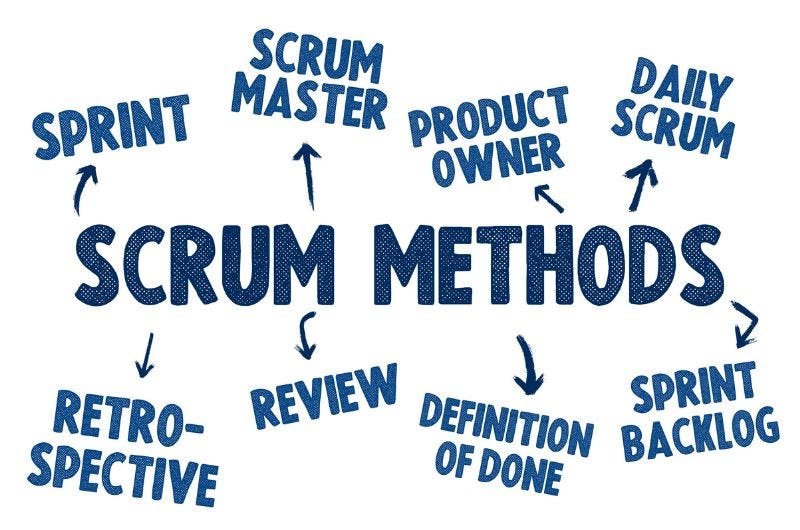Scrum Mastery: Your Roadmap to Agile Success – 15 Key Tips for Seamless Implementation
Our blog includes affiliate links. Your support helps us continue creating insightful content just for you. Each click makes a difference, helping us keep the lights on and the quality content flowing. Thanks for being a part of our journey - you make it all possible!
Hey there Agile enthusiasts! Are you looking to streamline your project management strategies? If so, you've landed in the right place. Today, we'll chat about the magical world of Agile and its popular framework, Scrum.
Agile is like your favorite superhero, swooping in to save the day from traditional project management woes. It's a collaborative, flexible, and iterative approach that keeps the focus on delivering the highest value to the customers. And the secret sidekick that makes Agile truly shine? That's Scrum!
Scrum, much like a trusty compass, navigates the ship of Agile projects through uncertain waters. It breaks down complex tasks into manageable 'Sprints', ensuring you don't bite off more than you can chew. Akin to chapters in a book, these Sprints let you focus on one narrative at a time, keeping confusion at bay.
The benefits of Scrum in Agile project management are truly a game-changer. It boosts team collaboration, enables flexibility, and dramatically improves product quality. If you want your projects to run as smoothly as a well-oiled machine, Scrum is your go-to.
For those of you just starting out, or even the seasoned pros, consider investing in a good Scrum guidebook or Agile project management tools to make your journey smoother.
Imagine Scrum as a play, where everyone has a role and there are key events taking center stage.
In the Scrum 'drama', we have three leading roles: the Product Owner, Scrum Master, and Development Team. The Product Owner is like the playwright, envisioning the story (the product) that needs to be told. They're in charge of the product backlog and prioritizing tasks based on value to the customer. For those donning the Product Owner's cap, the User Story Mapping book is a great tool to help you structure your product backlog.
The Scrum Master is akin to a director, facilitating the process, eliminating obstacles and ensuring that the team can perform at their best. They are the guardians of Scrum practices within the team. To help with this role, the Scrum Mastery book is an excellent read.
Finally, the Development Team are the actors, turning the vision into reality. They work on tasks during Sprints, which are short, time-boxed periods where specific tasks are completed.
There are key 'scenes' or events in Scrum: Sprint Planning, Daily Scrum, Sprint Review, and Sprint Retrospective. These events ensure constant communication, feedback, and adjustment, keeping the performance top-notch and the audience (customers) satisfied. For a detailed understanding of these events, Essential Scrum is your go-to guide.
We're diving into 15 practical tips to implement Scrum successfully, bringing you closer to Agile perfection. So, let's jump in!
Clearly Define the Roles Successful Scrum starts with clear roles. Product Owner, Scrum Master, Development Team - each has a unique part in the Scrum symphony. Misunderstanding these roles is like playing out of tune. Make sure everyone knows their part!
Effective Communication Scrum relies on regular, honest communication. Think of your Scrum team as a talkative family - everyone knows what's up with whom! Tools like Zoom and Slack can be life-savers for this. For more on effective communication, Nonviolent Communication is a good read.
Regularly Update the Product Backlog The product backlog is the heart of your Scrum project - it fuels your Sprints. It needs regular check-ups and tweaks. Prioritize backlog items based on their value. Check out User Stories Applied for more on this.
Effective Sprint Planning Sprint Planning is your roadmap. Plan your route carefully and make sure the whole team is on board. Agile Estimating and Planning is a handy tool here.
Hold Daily Scrum Meetings Daily Scrum meetings are like quick health checks. These stand-ups should discuss yesterday's achievements, today's goals, and any obstacles.
Encourage Team Collaboration The best Scrum teams are collaborative, supportive, and respectful. Encourage this culture. Try The Five Dysfunctions of a Team for ideas to boost team dynamics.
Implement Sprint Reviews Sprint Reviews let you check your progress and get feedback from stakeholders. Use this feedback to update the product backlog and improve. Essential Scrum can help you master this.
Conduct Effective Sprint Retrospectives Sprint Retrospectives offer an invaluable chance to reflect and learn. Use this opportunity to identify and implement improvements. Agile Retrospectives: Making Good Teams Great is a great guide for this.
Embrace Change and Flexibility Agile and change are two sides of the same coin. Welcoming change, even late in the development, leads to better end products. For more on this, Agile Change Management is an enlightening read.
Keep Sprints Short and Time-boxed Sprints should be short and sweet - usually 1-4 weeks. This ensures quick feedback loops and easier management. For more on effective Sprints, try Scrum: The Art of Doing Twice the Work in Half the Time.
Use the Right Tools Scrum tools like Jira, Trello, or Asana can streamline your processes and make life easier. Choose the one that suits your team best.
Foster a Culture of Continuous Improvement Improvement isn't a one-time thing in Scrum; it's continuous. Always aim to do better next Sprint.
Commit to Delivering Value Each Sprint should deliver value to your customers. Keep customer needs in focus while prioritizing your backlog.
Encourage Self-Organizing Teams Self-organizing teams take initiative, own their work, and deliver better results. Encourage this in your Scrum team. For tips on this, Creating Great Teams is a good read.
Implement Proper Training and Education Knowledge is power in Scrum. Ensure your team understands Scrum principles and practices thoroughly. Consider enrolling them in a good Scrum course or workshop.
Implementing these tips will help you navigate the Scrum seas smoothly, avoiding common pitfalls and sailing towards success. So, gear up and get your Scrum on!
Now, let's get real about the challenges you might face on this journey and how to power through them. After all, forewarned is forearmed, right?
Resistance to Change Change can be daunting and it's natural for teams to resist. It's key to communicate why Scrum will benefit everyone involved. For advice on managing resistance, Driving Technical Change is a must-read.
Understanding the Roles Misunderstandings about Scrum roles can lead to conflict or inefficiency. Regular training and clear communication can prevent this.
Overwhelming Product Backlog An unmanaged backlog is like a runaway train. Prioritize items based on their value and break larger items into manageable chunks. Fifty Quick Ideas to Improve your User Stories can provide valuable insights.
Poor Communication Unclear or infrequent communication can derail your Scrum journey. Encourage open, regular dialogue and active listening.
Lack of Stakeholder Engagement When stakeholders aren't invested, it's hard to deliver value. Keep them involved through Sprint Reviews and frequent updates.
Ineffective Retrospectives If retrospectives aren't leading to improvements, you're missing valuable learning opportunities. Make sure these sessions are open, focused, and result in actionable items. Agile Retrospectives: Making Good Teams Great is an excellent resource.
Long or Unfocused Sprints Sprints that drag on or lack clear goals can cause problems. Keep your Sprints short, focused, and goal-oriented. For insights on effective Sprints, grab Succeeding with Agile.
Inadequate Tools The wrong tools can hinder rather than help your Scrum process. Make sure your tools suit your team's needs and help you streamline your processes. The Project Management ToolBox: Tools and Techniques for the Practicing Project Manager might help you select the right tools.
Navigating these challenges can seem tough, but remember, every hurdle is an opportunity for growth. By being aware of potential problems and armed with solutions, you're well on your way to mastering Scrum.
To wrap it up, Agile buffs, we've voyaged through the fascinating landscape of Scrum - understanding its framework, exploring 15 top tips for successful implementation, and navigating through common challenges. All these insights are stepping stones to take your Agile project management to the next level, making it more efficient and collaborative.
Implementing Scrum may not be a cakewalk, but as you integrate these tips into your work, you'll see the transformation unfold. From clear role definition to continuous improvement, each tip paves the way for a more productive, value-driven environment.
And remember, it's all about embracing the Scrum mindset – welcoming change, valuing communication, and fostering a collaborative culture. Equip your team with good resources like Scrum: A Breathtakingly Brief and Agile Introduction, which offers an engaging overview of Scrum essentials.
In the end, Agile is a journey of learning, and every step, every hiccup, every success is a valuable lesson.
Happy Scrumming, folks! Let's build, learn, and deliver value.



